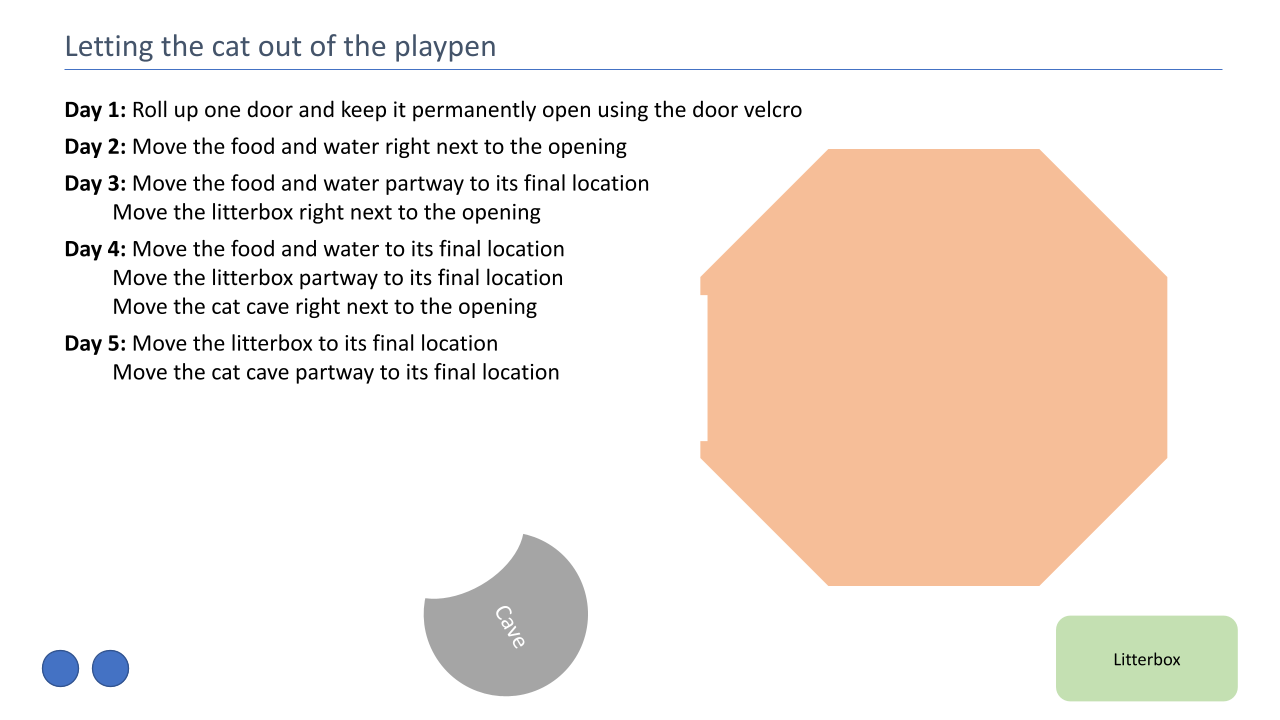
PRE-WORK:
Letting the cat out of the playpen
The primary reason we use the playpen is to control where the cat can go to ensure we can engage with the cat for the socialization sessions. When the cat immediately comes over to you when you sit down for a session, they’ve met the minimum requirement to let the cat out of the playpen. This point is the earliest point when you can let the cat out of the playpen but you could wait until the cat finishes the petting sequence before letting him out of the playpen. It depends on your living situation and available rooms.
Every time we introduce a change (or a vet visit), the cat will get nervous. Expect the cat to regress a little, but as long as you go back 1 to 2 steps after the change the cat will bounce back to where he left off within a week. So after you let the cat out of the playpen, ignore the cat the first day and night. The next day, sit in the middle of the room with your legs extended and play with the toy and slow blink the cat. Toss the cat some dry treats and show the cat the wet treat (lick mat or squeezable treat) and see if the cat will come to you. If not, then leave it at the slow blinks. Repeat each day until the cat is comfortable enough to approach you again, then have the cat cross your extended legs at the ankle, then the shin, then the thighs. Once the cat is comfortable with that again, move on to 4 paws up on your lap (with your legs extended).
Why do we do this? Let the cat roam
We don’t want to keep the cat in a playpen too long. It is also important to let the cat roam so that in addition to the sessions we can work on the Approach Sequence. The Approach Sequence works on getting the cat to not run away when you approach. When the cat is in a playpen, he can’t run away so we can’t work on that. Most adopters want to be able to approach the cat without the cat running away, so this is a vital skill to work on with them.
Letting the cat out of the playpen
When we let the cat out of the playpen, we leave the playpen there for a week and slowly take out the items. This lets the cat gradually get used to the change and makes the playpen available as a safe and familiar “homebase.” Even if the cat runs out and hides at another corner of the room, still follow these steps.
Letting the cat out of the playpen video
A video with some tips on how to let the cat out of the playpen. This is a good view to show you what I mean by permanently rolling up and velcroing the playpen door. In this video I have the top unzipped because I had just finished a session with the cat, but I leave the top zipped up when I’m not doing a session.
How to fold up the playpen
I make a “W” shape with the corners of the play pen. Do it so that the elastic band is on an outer edge (or the top middle point of the “W”) so that when you are done, you can wrap the playpen with the elastic band. After making the “W”, it will not fully flatten because you have the floor in between the walls. I turn it upside down, hold the middle of the floor and shake it to pull all of the floor out, then fold the floor over one side.
Greeting you at the door
We train the cat to come greet us when we come into the room so that the cat becomes comfortable every time someone walks in. Ideally, you want to do this every time you walk in. If you walk into the room often (more than 10x a day), use a tasty flavor of dry kibble instead of the treats because you should give only a maximum of 10 - 15 dry treats a day so that the cat doesn’t get diarrhea.





